The digital battlefield has become a force multiplier in the 21st century that has reshaped how military forces around the globe prepare for and overcome regional and international competitors' issues. Land vehicles, having become beneficial, interlinked nodes in the field with all-new tactical and logistical abilities, have not escaped the significant impacts of digitalization. The number of advanced electronic systems at ground level has increased over the last two decades as defence departments aim to build their armed forces lighter, faster, and ready to deploy.
The electronic equipment associated with vehicles that are mainly operated by defence sectors is part of Vetronics. These include different systems including navigation systems, display systems, C3 systems, weapons control systems, vehicle protection systems, power systems, which are used to improve combat capabilities and spatial awareness of military vehicles, among others. Also, these systems are crucial in improving the efficiency of land vehicles and their role in network-centered integrated warfare operational activities.
Variables such as focusing on improving frontlines situational awareness and increasing occurrences of asymmetric and network-centered warfare have a major positive impact over the military land vehicle electronics (Vetronics) market. Moreover, the increase in defence spending, particularly in emerging economies, and subsequent investments in the procurement of such systems are further boosting the growth of the market. Factors such as strict regulations and consequent delays in procurement processes, however, hinder the growth of the market to some extent. Increasing terrorist attacks and a focus on counter operations, and the launch of vehicle modernization programs by many nations around the world, have created promising opportunities for the military land vehicle electronics (Vetronics) market to grow.The market revenue for Global Military Land Vehicle Electronics (Vetronics) Market accounted for USD 3.64 Billion in the year 2020 and it is anticipated to reach a value of around USD 6.01 Billion by the year 2028. The market growth dynamics account for a CAGR of 5.73% during the forecast period, 2020-2028.
North America is expected to dominate the global market with a market value of USD 1.92 Billion owing to the increasing R&D investment in this sector coupled with an infrastructure that supports the same. The early adoption of Vetronics technology in North America is another factor that fuels its market growth. Europe is expected to be the second-largest market with a value of USD 1.50 Billion. APAC is expected to grow with the highest CAGR of 6.17%.
The report is aimed at:
- The key drivers, restraints, and challenges which are expected to shape the Global Military Land Vehicle Electronics (Vetronics) Market are covered in detail in the report.
- The key technologies which could have an impact on the Global Military Land Vehicle Electronics (Vetronics) Market have been covered in detail.
- The top fifteen countries have been analyzed in detail , the analysis includes military spending, vehicle & artillery, and upcoming projects.
- The Porter’s Five Forces and the PEST Analysis of the Global Military Land Vehicle Electronics (Vetronics) Market have been covered in the report.
- The high growth markets have been identified in the Opportunity Analysis Chapter.
- The market has been forecasted from 2020- 2028 considering all the factors, which is expected to impact the market.
- The Scenario Analysis Chapter covers the key scenarios and their impacts on the forecast chapter.
Segmentation covered in this report
The market is segmented based on Region, Vehicles, and System:By Region:
- North America
- Europe
- APAC
- Middle East
- ROW
By Vehicles:
- MBT
- APC
- LAV
- MRAP
- Others
By System:
- Fire Control Systems
- Electronic Warfare and C4 Systems
- Navigation Systems
- Display Systems
- Sensor Monitoring & Control
- Power Systems
Country Analysis
- USA
- France
- China
- Russia
- South Korea
- Israel
- India
- Italy
- United Kingdom
- Germany
- Japan
- Australia
- Singapore
- Spain
- Canada
- The new players in the Global Military Land Vehicle Electronics (Vetronics) Market and the potential entrants into this market can use this report to understand the key market trends that are expected to shape the market in the next few years.
- The Market Analysis Chapter covers the Key Drivers, Restraints, and Challenges of the Vetronics technology. The PEST and Porter’s five forces are covered in detail in this report.
- The key technologies that could impact the Global Military Land Vehicle Electronics (Vetronics) Market have been covered in detail.
- The report can be used by the sales and marketing team to formulate their medium- and long-term strategies and to reconfirm their short-term plans.
- The forecast chapter would help the sales team to formulate their medium-term sales plan.
- The report would help the sales and the marketing team to understand the key segments across the top fifteen countries which have been analyzed in the report.
- The Opportunity Analysis chapter identifies the key hot spots within the Global Military Land Vehicle Electronics (Vetronics) Market.
- The company profiles include financials, latest news, and SWOT analysis for ten companies.
Department of Defense: Defense department and other Governmental Organizations involved with the research and development of defense strategies using Vetronics can use this report to support their research.
Department of Information Technology: The Department of Information Technology could use this report to understand various technical indicators of the top ten countries. This would give them an overall perspective of potential markets.
Decision Makers: The future investment and technology focus decisions could be formulated based on the inputs of this report.
Other Organizations: Various other NGO and Non- Governmental organizations involved with the research of the development department for upcoming technologies can use this report to support their research.




